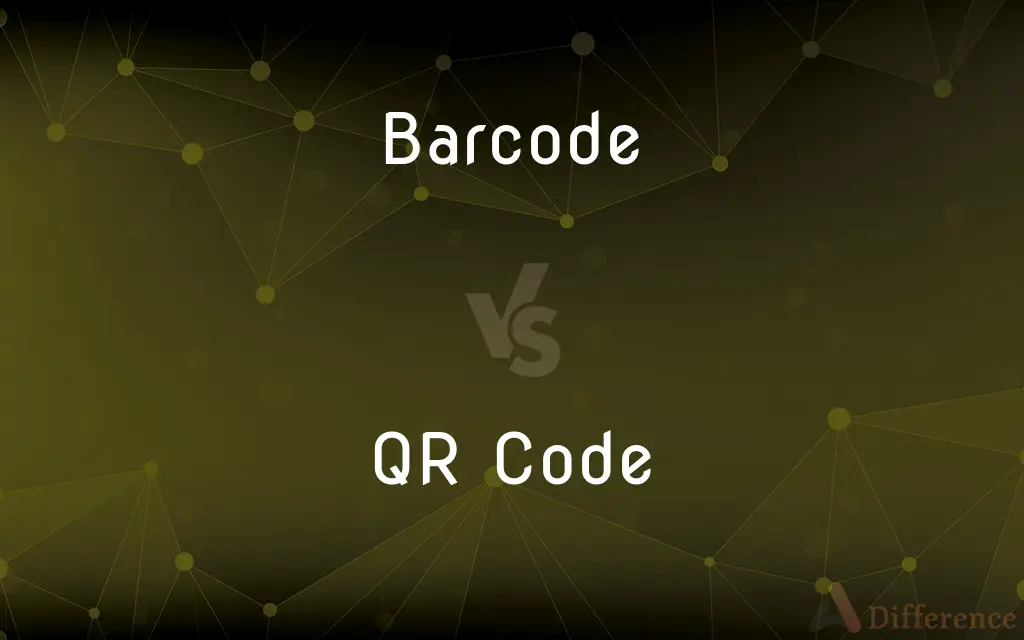Barcode vs. QR Code — What's the Difference?
By Tayyaba Rehman — Published on January 7, 2024
Barcode is a graphical representation of data using lines and spaces. QR Code is a two-dimensional matrix barcode capable of storing more data, including URLs and text.

Difference Between Barcode and QR Code
Table of Contents
ADVERTISEMENT
Key Differences
A Barcode is a method of representing data in a visual, machine-readable form. It consists of a series of lines and spaces of varying widths that encode information. Barcodes are widely used in retail for product identification, inventory management, and tracking.
A QR Code, short for Quick Response Code, is a type of 2D barcode. Unlike traditional barcodes, QR Codes store data both horizontally and vertically, enabling them to hold more information, such as URLs, contact details, or text. QR Codes are commonly used in marketing, ticketing, and mobile applications.
Barcodes encode data by varying the widths and spacings of lines, limiting the amount of information they can carry. In contrast, QR Codes use a grid of squares to store data, making them capable of holding more extensive information.
Barcodes are primarily used for simple data like product numbers, while QR Codes are versatile and can store URLs, text, contact details, or even trigger actions on smartphones, making them suitable for a broader range of applications.
Comparison Chart
Definition
Line-based data representation
2D matrix barcode
ADVERTISEMENT
Data Capacity
Limited
Extensive, including URLs
Encoding
Varying line widths and spacings
Grid of squares
Applications
Product identification, inventory
Marketing, mobile apps
Compare with Definitions
Barcode
Barcode encodes data in lines.
Scanning a barcode on a product.
QR Code
QR Code stores data in a grid.
Scanning a QR Code for a website link.
Barcode
Machine-readable data representation.
Barcode for ticket validation.
QR Code
Contains extensive information.
Using QR Codes for event tickets.
Barcode
Lines represent information.
Barcodes on library books.
QR Code
Mobile-friendly data encoding.
Scanning a QR Code to make a payment.
Barcode
Common in retail for tracking.
Using barcodes in supermarkets.
QR Code
Versatile for various data types.
QR Code on a business card.
Barcode
Limited data capacity.
Barcode on a shipping label.
QR Code
Two-dimensional matrix barcode.
QR Code for contact details.
Barcode
A series of vertical bars of varying widths, in which each of the digits zero through nine are represented by a different pattern of bars that can be read by a laser scanner. The bars are commonly found on consumer products and are used especially for inventory control.
Barcode
A DNA barcode.
Barcode
Bar·cod·ed, bar·cod·ing, bar·codes To provide or mark (an item) with a barcode.
Barcode
To DNA barcode.
Barcode
Any set of machine-readable parallel bars or concentric circles, varying in width, spacing, or height, encoding information according to a symbology.
Barcode
(genetics) A portion of a gene that identifies a particular species.
Common Curiosities
What is a Barcode?
A Barcode is a graphical representation of data using lines and spaces.
How do QR Codes differ from Barcodes?
QR Codes store more data in a two-dimensional grid, while Barcodes use lines and spaces with limited data capacity.
What are Barcodes used for?
Barcodes are commonly used for product identification, inventory management, and tracking in retail.
What is a QR Code?
A QR Code, or Quick Response Code, is a two-dimensional matrix barcode capable of storing various types of data, including URLs and text.
Where are Barcodes typically found?
Barcodes are often found on retail products, library books, and shipping labels.
What types of information can QR Codes store?
QR Codes can store URLs, contact details, text, and trigger actions on smartphones.
Are QR Codes more versatile than Barcodes?
Yes, QR Codes are more versatile due to their ability to store extensive information and trigger actions on smartphones.
How do I scan a Barcode?
You can scan a Barcode using a Barcode scanner or a smartphone with a built-in camera and a Barcode scanning app.
What are the advantages of using QR Codes in marketing?
QR Codes can provide quick access to websites, promotions, and contact information, enhancing user engagement.
How do QR Codes benefit event ticketing?
QR Codes simplify the ticketing process by providing quick access to event details and enabling electronic ticket validation.
Where are QR Codes commonly used?
QR Codes are used in marketing, mobile applications, event tickets, and business cards.
Are QR Codes secure for storing sensitive information?
QR Codes can store sensitive data, but it's important to ensure proper security measures are in place when using them.
Can QR Codes be used for mobile payments?
Yes, QR Codes are often used for mobile payment methods, allowing users to make payments by scanning the code.
Do Barcodes require specialized equipment to read?
Barcodes can be read with a Barcode scanner or a smartphone app equipped with Barcode scanning capabilities.
Can QR Codes be customized with logos or colors?
Yes, QR Codes can be customized with logos and colors to match branding, while Barcodes are typically standardized.
Share Your Discovery

Previous Comparison
3NF vs. BCNF
Next Comparison
Free Radical vs. IonAuthor Spotlight
Written by
Tayyaba RehmanTayyaba Rehman is a distinguished writer, currently serving as a primary contributor to askdifference.com. As a researcher in semantics and etymology, Tayyaba's passion for the complexity of languages and their distinctions has found a perfect home on the platform. Tayyaba delves into the intricacies of language, distinguishing between commonly confused words and phrases, thereby providing clarity for readers worldwide.
















































